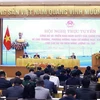A new Asian Development Bank (ADB) report has showed that continued tepid demand from the major industrial economies coupled with China’s slower growth are weighing on the outlook for developing Asia.
The latest ‘Asian Development Outlook Supplement’ released on July 16 trimmed the 2013 growth forecast for the 45 developing member countries of ADB to 6.3 percent and cut its 2014 forecast to 6.4 percent. In April, ADB had predicted the region to grow 6.6 percent this year and 6.7 percent next year.
“The drop in trade and scaling back of investment are part of a more balanced growth path for China, and the knock-on effect of its slower pace is definitely a concern for the region. But we are also seeing more subdued activity across much of developing Asia ,” said ADB Chief Economist Changyong Rhee.
According to the report, China - home to developing Asia’s largest economy - is likely to see its economy expand 7.7 percent this year and 7.5 percent in 2014 after a growth of 7.8 percent in 2012.
China’s slower growth has subdued the outlook for the entire East Asia region as well as, to a lesser extent, for Southeast Asia where the Philippines and other large ASEAN countries are otherwise seeing solid growth.
In India , meanwhile, slow progress in pushing through the reforms needed to ease business bottlenecks means growth is likely to be 5.8 percent this year, slower than the previously forecast of 6.0 percent. ADB maintains its 2014 forecast of 6.5 percent for 2014.
Elsewhere in South Asia, Sri Lanka continues to grow strongly while other parts of the region will see softer than anticipated growth.
The report also trimmed forecasts for Central Asia, reflecting the sluggish economic performance of Kazakhstan and Georgia, and for the Pacific where Timor-Leste is seeing a slowdown in government spending.
Inflation pressures, meanwhile, are waning on the back of declining energy and food prices, given slower global demand for fuels and bumper grain harvests.
A DB, based in Manila, is dedicated to reducing poverty in Asia and the Pacific through inclusive economic growth, environmentally sustainable growth and regional integration.
Established in 1966, it is owned by 67 members – 48 from the region. In 2012, ADB assistance totaled 21.6 billion USD, including cofinancing of 8.3 billion USD.-VNA
The latest ‘Asian Development Outlook Supplement’ released on July 16 trimmed the 2013 growth forecast for the 45 developing member countries of ADB to 6.3 percent and cut its 2014 forecast to 6.4 percent. In April, ADB had predicted the region to grow 6.6 percent this year and 6.7 percent next year.
“The drop in trade and scaling back of investment are part of a more balanced growth path for China, and the knock-on effect of its slower pace is definitely a concern for the region. But we are also seeing more subdued activity across much of developing Asia ,” said ADB Chief Economist Changyong Rhee.
According to the report, China - home to developing Asia’s largest economy - is likely to see its economy expand 7.7 percent this year and 7.5 percent in 2014 after a growth of 7.8 percent in 2012.
China’s slower growth has subdued the outlook for the entire East Asia region as well as, to a lesser extent, for Southeast Asia where the Philippines and other large ASEAN countries are otherwise seeing solid growth.
In India , meanwhile, slow progress in pushing through the reforms needed to ease business bottlenecks means growth is likely to be 5.8 percent this year, slower than the previously forecast of 6.0 percent. ADB maintains its 2014 forecast of 6.5 percent for 2014.
Elsewhere in South Asia, Sri Lanka continues to grow strongly while other parts of the region will see softer than anticipated growth.
The report also trimmed forecasts for Central Asia, reflecting the sluggish economic performance of Kazakhstan and Georgia, and for the Pacific where Timor-Leste is seeing a slowdown in government spending.
Inflation pressures, meanwhile, are waning on the back of declining energy and food prices, given slower global demand for fuels and bumper grain harvests.
A DB, based in Manila, is dedicated to reducing poverty in Asia and the Pacific through inclusive economic growth, environmentally sustainable growth and regional integration.
Established in 1966, it is owned by 67 members – 48 from the region. In 2012, ADB assistance totaled 21.6 billion USD, including cofinancing of 8.3 billion USD.-VNA



















